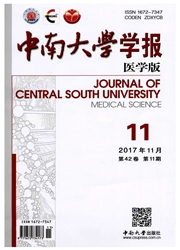

 中文摘要:
中文摘要:
目的:探讨维生素C治疗百草枯(paraquat,PQ)中毒大鼠的疗效及量效关系。方法:将40只Sprague,Dawley(SD)大鼠随机分为对照组、中毒组和维生素C1组、c2组,每组10只。通过胃内一次性灌注150mg/kgPQ建立PQ中毒sD大鼠模型。中毒组给予30mg/kg甲基强的松龙、2.5mg/kg环磷酰胺腹腔注射;维生素C1组、C2组在中毒组基础上给予两种浓度的维生素C(5,500mg/kg),以生理盐水稀释成5mL/kg,股静脉注射;对照组仅以生理盐水进行相应处理。于实验后36h检测大鼠血浆中丙二醛、肝肾功能,并行动脉血气分析,采血后处死大鼠取肺组织行病理切片、湿干重比等检查;取肝组织行比色法检测谷胱甘肽过氧化物酶(glutathione peroxidase,GSH,PX),Western印迹检测Bcl-2表达等。结果:维生素Cl组中丙二醛低于中毒组,GSH—PX高于中毒组,肝肾功能较中毒组有明显改善(均P〈0.01);维生素C2组丙二醛高于中毒组,其肝肾功能较中毒组也呈恶化趋势(均P〈0.01)。中毒组中Bd.2较对照组表达减低,维生素C1组中Bcl-2较中毒组表达增强,而维生素C2组中Bcl-2较中毒组表达减弱(均P〈0.01)。但维生素C1组、C2组在肺功能、湿干重比、病理学等与中毒组差异无统计学意义(均P〉0.05)。结论:低剂量维生素C可能通过抗氧化、抑制PC导致的细胞凋亡等途径对PQ中毒大鼠的肝肾功能有部分的保护作用,而高剂量维生素C反而有促氧化作用;同时,维生素C未呈现出对PC峥毒时肺的保护作用。
 英文摘要:
英文摘要:
Objective: To explore the dose-effect relationship between vitamin C and paraquat (PQ) poisoning rats. Methods: A total of 40 Sprague-Dawley (SD) rats were randomly divided into 4 groups: a control group, a PQ.poisoning group, a vitamin c group i and a vitamin C group 2 (n=10 in each group). 150 mg/kg PQwas perfused into rat stomach to establish PO..poisoning rat model. In PQ poisoning group, 30 mg/kg methylprednisolone and 2.5 mg/kg cyclophosphamide were injected peritoneally on the basis of PQ.poisoning rat model. In vitamin C 1 and C2 group, vitamin C was injected at a dosage of 5 or 500 mg/kg, respectively. The control group only received normal saline (NS). Xhe malondialdehyde (MDA), liver and kidney function as well as arterial blood gas in the blood were examined 36 h later. At the end, the rats were killed and took the liver tissues for pathological examination and weight ratio calculation. The glutathione peroxidase (GSH-PX), ctychrome C (Cyt C) in the liver tissues were detected by chromatometry, and the Bd-2 was detected by Western blot. Results: Compared with the PQpoisoning group, the MDA and Cyt C were decreased, the GSH-PX was increased, and liver and kidney functions were improved in the vitamin C group 1 (all P〈0.01); but in the vitamin C group 2, the MDA increased and liver/kidney functions were impaired (all P〈0.01). The expression of Bcl-2 in the PQ_poisoning group was lower than that in the control group; compared with the PQ poisoning group, it was increased in the vitamin C1 group, while it was decreased in the vitamin C group 2 (both P〈0.01). There was no obvious difference in the lung function, wet/dry weight ratio and pathological changes between the poisoning group and experimental groups (all P〉0.05). Conclusion: Vitamin C at the low dose shows a certain degree of protection for the liver and kidney in the PQpoisoning rats model through it antioxidative activity and anit-apoptosis activity, while vitamin C at the high does m
 同期刊论文项目
同期刊论文项目
 同项目期刊论文
同项目期刊论文
 期刊信息
期刊信息
